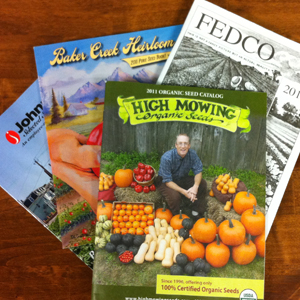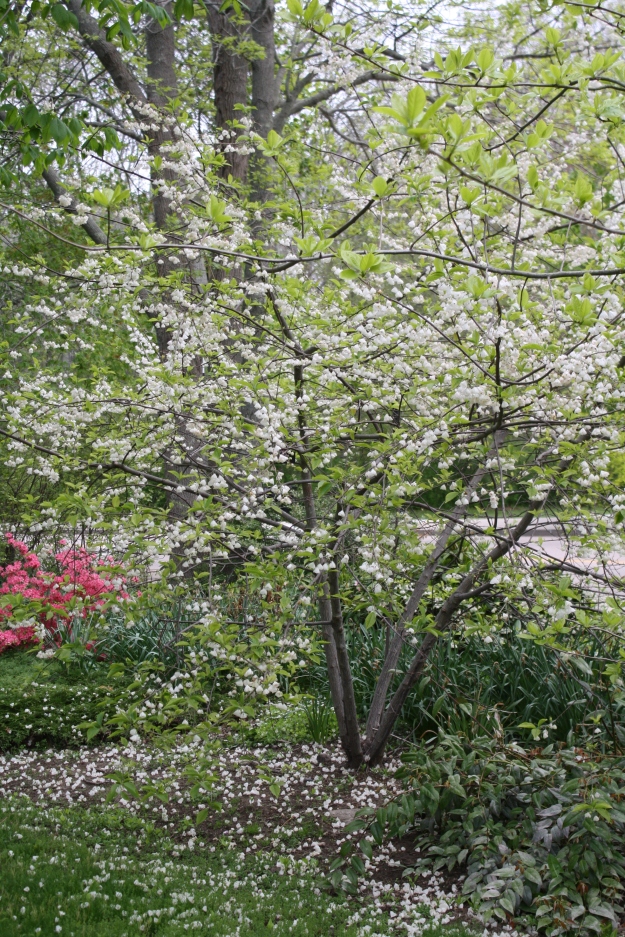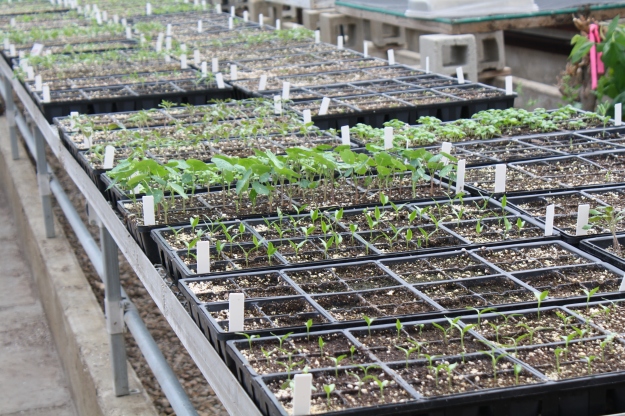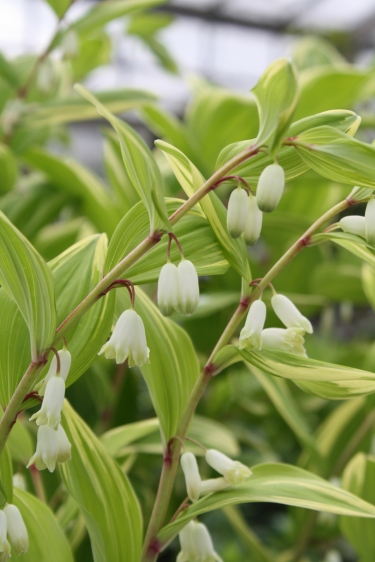Tag Archives: gardens
Into July
It’s been quite a while since the last post! With the weather fine and dry through most of June, we spent all our days out in the garden. Now it’s hot and humid, with a tropical storm predicted for Independence Day. It seems early for hurricanes*, but hey, I’m not a meteorologist, I’m a gardener. And so, here are pictures of the garden. Lots of color as we head into full summer!
* Hurricane Rhyme…… “June: too soon, July: stand by, August: upon us, September: remember, October: all over.”
Either a “mariner’s proverb”, or a “Carribean folk saying”, reportedly first published in “Weather Lore” by R. Inwards in 1898.
Catching Up
 We started early Friday morning, loading plants into the stake body truck borrowed from Agronomy (as well as two pickups). Off to East Farm! (it’s only a mile.)
We started early Friday morning, loading plants into the stake body truck borrowed from Agronomy (as well as two pickups). Off to East Farm! (it’s only a mile.)

 It rained a little (of course). Two large loads in the stake body and two loads in each pick up, then we set it all up and went home. Saturday started bright and early again, with a hundred or more people lined up before the gate opened at 9 am! We talked plants nonstop all day and sold most of them. Brought the leftovers back in one pickup and now we are catching up in the Botanical Garden for Commencement this weekend!
It rained a little (of course). Two large loads in the stake body and two loads in each pick up, then we set it all up and went home. Saturday started bright and early again, with a hundred or more people lined up before the gate opened at 9 am! We talked plants nonstop all day and sold most of them. Brought the leftovers back in one pickup and now we are catching up in the Botanical Garden for Commencement this weekend!
Count Down: Plant Sale 2014
The countdown is on to Saturday, May 10th!
Come see us at the East Farm Spring Festival! The URI Botanical Gardens will be selling Annuals, Garden-dug Perennials, and vegetable seedlings. All-America selections, heirloom varieties, and more. All proceeds benefit the Botanical Gardens!
Free parking, gardening demonstrations, vendors, food, children’s activities.
Saturday May 10th, 9 am to 2 pm
Linked To Gardens Past
First, I was reading a book called “The Signature of All Things” by Elizabeth Gilbert (my friend Jane said “You should read it! it’s all about moss!”). It sort of is, it’s about a woman who is a botanist in the early 19th century. A few days later, I was reading Botany Photo of the Day, with an entry about a plant named for a woman, Jeanne Baret (1740-1807). Baret disguised herself as a man to go on a botanizing expedition in the 1760s, on a voyage to South America, Mauritius, and Madagascar. A commenter on the BPoD post mentioned (along with names of many women botanists, who I had great fun looking up) a book titled “Merry Hall” by Beverley Nichols. The commenter said that in the book Nichols tells the story of Jeanne Baret. So then I decided to read that book. Well, it turns out that he briefly mentions the story rather than fully telling it. I read it anyway. “Merry Hall” is a gardening book in a very old-fashioned sense –Beverley Nichols bought an English estate, and hired gardeners and laborers to create his vision of the surrounding gardens. But here’s what I am getting to: Despite being written over sixty years ago, how he felt about his garden sounds remarkably like how I feel about my gardens, and perhaps how you feel about yours. Listen….
“…an important truth about the gardener’s life as opposed to the lives of other people – the fact that each new year is more startling and more rich in beauty than the one that preceded it.”
“An encore in the garden, unlike an encore in a concert hall, is almost always more exciting than the original performance; to do something for the second time in a garden is always better than doing it for the first, and the third time is better still, and the fourth and fifth, ad infinitum. Every time you push aside the damp frosty leaves…to greet the first snowdrops, the flowers seem to gleam with a purer white; and time cannot wither, nor custom stale, the beauty of (the) line about the snowdrop… ‘And hails far summer with a lifted spear’ .”
About spraying insecticides: “…perhaps there may be, somewhere in the world, somebody who is as silly as I am on these matters, someone who worries beyond all reason about the trials and tribulations of very small- -and often unalluring – creatures who are regarded by ‘normal’ people as only fit to be trodden underfoot. Though few insects are less alluring, though they are an infernal nuisance and probably a mass of germs, that is not the point. However unpleasant they maybe, God made them that way, and somehow I feel that it is all wrong to assume this role of mass torturer.”
“I believe ..if it were possible to take…a psychic photograph of a gardener, you would find that there would be ghostly tendrils growing from the tips of his fingers, and shadowy roots about his feet, and a pattern of ectoplasmic lines that linked him in a natural rhythm with the curve and sway of the branches about him. And..if this same picture were taken when he was removed from his natural environment…tendrils and roots would be starved and stunted, the rhythm broken. ‘Green fingers’… is a fact in physiology.”
“When I begin to write about flowers I lose all sense of restraint, and it is far, far too late to do anything about it. You cannot say you have not been warned.”
I would love to hear about your favorite garden writing, old or new!
Catalog Season
Earlier this week Andy handed me a new seed catalog. I hadn’t gotten any in the mail yet and so I hadn’t started that delicious daydreaming about springtime, gardening, warm weather, and especially, seeds. So let the daydreaming begin, that’s what January is for if you’re a gardener. I adore seed catalogs; there is something so old fashioned about them. Pictures of impossibly beautiful vegetables and flowers, with over-the top-descriptions of how tasty, productive and gorgeous they are! The earliest, sweetest peas, the best tomatoes you ever had, giant pumpkins. The biggest zinnias, the tallest sunflowers, and the most fragrant sweet basil! Not to mention that seeds are one of the best investments you can make. I’m a sucker for all of it, and being a little old-fashioned myself, I like the actual paper catalog in my hand, by the woodstove, with a cup of coffee.
 Last fall I emptied my two giant cookie tins full of seeds and sorted them with a critical eye. I composted any which were more than three years old, and I was surprised at how many that was. Time to buy some new seeds. I’m looking at old favorites like Benary Giant Zinnias and Northeaster Pole Beans. I’ve only gone through the Johnny’s and High Mowing catalogs…impatiently awaiting Fedco (top favorite), and Territorial (they are selling wasabi plants!) and Cook’s Garden, and Nichols…. I found many enticing new-to-me varieties: Esterina cherry tomato, (“sweeter than Sungold and resists cracking”!) Listada di Gandia Eggplant, Calypso Pickling Cucumber. Veronica Romanesco Cauliflower: stunning! Or how about Painted Lady Sweet Peas ( “This variety dates to 1737 and was planted by Jefferson at Monticello in the early 1800s.”). I have never had much luck with Sweet Peas –it gets too hot early on here –but I ‘m convinced I should try again…
Last fall I emptied my two giant cookie tins full of seeds and sorted them with a critical eye. I composted any which were more than three years old, and I was surprised at how many that was. Time to buy some new seeds. I’m looking at old favorites like Benary Giant Zinnias and Northeaster Pole Beans. I’ve only gone through the Johnny’s and High Mowing catalogs…impatiently awaiting Fedco (top favorite), and Territorial (they are selling wasabi plants!) and Cook’s Garden, and Nichols…. I found many enticing new-to-me varieties: Esterina cherry tomato, (“sweeter than Sungold and resists cracking”!) Listada di Gandia Eggplant, Calypso Pickling Cucumber. Veronica Romanesco Cauliflower: stunning! Or how about Painted Lady Sweet Peas ( “This variety dates to 1737 and was planted by Jefferson at Monticello in the early 1800s.”). I have never had much luck with Sweet Peas –it gets too hot early on here –but I ‘m convinced I should try again…
As I said in this post, every year I plant seeds and every year I am thrilled and amazed when the seedlings push up through the soil. What are you daydreaming about this January?
At the End of the Year
For the last blog of the year here are a few favorite pictures from 2013. Some of them are of beautiful things and some of them just make me smile, like the picture of all the seedlings coming up for the plant sale. Happy New Year!

January 24th 2013, frost patterns on the glass inside the Conservatory. Temperature outside was -3 F.
Good Help Is….
I was thumbing through a copy of “The New Organic Grower” by Eliot Coleman the other day. (This little book, which was published in 1989, is worth a read, just for attitude!) What caught my eye was: “A good employee who is familiar with your operation is worth three who are not.” Obviously this is true, and it is one of the challenges of working in an educational setting. Students come and go! I have often wished I could just hire a particular student to work with me as a regular employee, but that’s not how it is. They work part time, in between classes. They take time off during exams (first week of May–how inconvenient!). They find jobs “at home” and move away. They graduate!
This year, I have been really fortunate to have great students working with me, and plenty of help. I have three volunteers, and three student employees. A few of them worked with me last year and that is where the work that goes into training a new employee really pays off –when they stay and become the one who is “familiar with your operation”. So, let me introduce them and their answers to the question “What do you like about working in the Gardens/Greenhouse?”
 Lauren is a senior from South Kingstown, RI, studying Studio Art with a double minor in Horticulture and Italian (!). She was an intern at the Phipps Conservatory last summer, came back to URI in September offering to volunteer at the Gardens, and was quickly offered a student employee position. Lauren said, “I like working at the greenhouse because it is very rewarding and I learn things every time I’m here.” She is a fearless slayer of insects.
Lauren is a senior from South Kingstown, RI, studying Studio Art with a double minor in Horticulture and Italian (!). She was an intern at the Phipps Conservatory last summer, came back to URI in September offering to volunteer at the Gardens, and was quickly offered a student employee position. Lauren said, “I like working at the greenhouse because it is very rewarding and I learn things every time I’m here.” She is a fearless slayer of insects.
 Adam is a junior from Cumberland, RI, studying Horticulture. He came to the Greenhouse looking for a job, any job, decided he liked it, and stayed. Adam said, “I like working at the Garden, because, along with providing work that is rewarding, it gives me a place to “escape” to. Devoid of the typical hustle and bustle sensibilities, it lets me be myself and work with very interesting people who I thoroughly enjoy and respect.” If you see Adam, ask him what’s on the ipod.
Adam is a junior from Cumberland, RI, studying Horticulture. He came to the Greenhouse looking for a job, any job, decided he liked it, and stayed. Adam said, “I like working at the Garden, because, along with providing work that is rewarding, it gives me a place to “escape” to. Devoid of the typical hustle and bustle sensibilities, it lets me be myself and work with very interesting people who I thoroughly enjoy and respect.” If you see Adam, ask him what’s on the ipod.
 Dennise is a senior from Pawtucket, RI, studying Animal Science, pre-Vet. She is a dedicated volunteer who also volunteers with the Biocontrol program here at the greenhouse. Dennise said, “For all the years I’ve spent at URI, the Garden has served as an escape from the madness that surrounds college life. It reminds me to sit still and be patient because, not unlike the foliage surrounding those weathered but sturdy benches, growth takes time. Every seed planted holds a promise of a new beginning, if given the proper care. This is why it is an honor for me to be a part of a process that reminds me to continue to grow despite rough weather. In the classroom, we are constantly urged to “wake up and smell the coffee”, but I’ve found it far more rewarding to “stop and smell the flowers”.” In addition to animals and plants, Dennise loves music and plays the piano.
Dennise is a senior from Pawtucket, RI, studying Animal Science, pre-Vet. She is a dedicated volunteer who also volunteers with the Biocontrol program here at the greenhouse. Dennise said, “For all the years I’ve spent at URI, the Garden has served as an escape from the madness that surrounds college life. It reminds me to sit still and be patient because, not unlike the foliage surrounding those weathered but sturdy benches, growth takes time. Every seed planted holds a promise of a new beginning, if given the proper care. This is why it is an honor for me to be a part of a process that reminds me to continue to grow despite rough weather. In the classroom, we are constantly urged to “wake up and smell the coffee”, but I’ve found it far more rewarding to “stop and smell the flowers”.” In addition to animals and plants, Dennise loves music and plays the piano.
 Ben is a sophomore from South Kingstown, RI, studying Landscape Architecture. He spent last summer working 60-70 hours a week for a high end landscaping company near Albany, NY. Ben said, “I like learning about the care and maintenance of plants in the greenhouse setting. It gives me a lot of real world experience that I don’t find in the classroom.” He is planning to start his own landscape construction business.
Ben is a sophomore from South Kingstown, RI, studying Landscape Architecture. He spent last summer working 60-70 hours a week for a high end landscaping company near Albany, NY. Ben said, “I like learning about the care and maintenance of plants in the greenhouse setting. It gives me a lot of real world experience that I don’t find in the classroom.” He is planning to start his own landscape construction business.
 Samantha is a junior from Washington, DC, studying Environmental Science. She began volunteering last year and came back again in September to continue. Samantha said, “Volunteering at the Greenhouse is a great way to learn more about plants and how to complete tasks like propagating and pruning. It is also a way for me to decompress and take a break from my stressful week.” Samantha came to Rhode Island hoping for more snowy, wintery winters than in Washington.
Samantha is a junior from Washington, DC, studying Environmental Science. She began volunteering last year and came back again in September to continue. Samantha said, “Volunteering at the Greenhouse is a great way to learn more about plants and how to complete tasks like propagating and pruning. It is also a way for me to decompress and take a break from my stressful week.” Samantha came to Rhode Island hoping for more snowy, wintery winters than in Washington.
As I was beginning this post, another volunteer, Emily, told me that she wouldn’t be able to come in any more until next semester. I know, school comes first, that’s why you are here! So a special thanks to all of you who help us keep the Gardens and Greenhouses looking good and running smoothly.
Fall Is the Best Time To Plant
“Fall is the best time to plant” That’s what I tell my students (and anyone who asks). The shorter days and cooler temperatures make it easier for transplants to spread their roots without us hovering nearby with the sprinkler. Usually there’s some rain too, though not this fall, not much. But the dry weather is not nearly the problem it would be in the spring and so we are madly digging and dividing perennials all over the garden.
Why divide? After a few years — as few as 3 or as many as 10 — perennial plants begin to lose vigor. Often they grow toward the outside, leaving an empty space in the middle like a bird’s nest. They may flower less, have smaller leaves, or flop over more. They may also have gotten too big for their space in the garden. Dividing re-invigorates the plants, and as Tracy Aust says, “It can be very satisfying, having a rejuvenating effect on perennial and gardener alike.”
Of course, after digging and dividing and transplanting, you may have more plants than you can use. I overwinter many garden-dug perennials for our spring plant sale, but space is at a premium this year. A truckload of perennials has been donated to two local schools, saving me from having to compost them. Thanks Jayne and Hilary, for gardening with the kids!
One last thought about digging and dividing: the plants may not look great at first but in the spring they’ll look better than ever.
 The Hosta bed under the Metasequoia was dug up and replanted.
The Hosta bed under the Metasequoia was dug up and replanted.
 Over near the Co-operative Extension parking lot we put in new plants to go with these great Chrysanthemums that look like pink daisies.
Over near the Co-operative Extension parking lot we put in new plants to go with these great Chrysanthemums that look like pink daisies.
 Lauren and I dug, divided, and replanted Bee Balm in the ericacious garden and the sunny border. We also took some Siberian Iris out of a bed that was too shady and put in Ligularia, which I think will do well in this moist, shady spot.
Lauren and I dug, divided, and replanted Bee Balm in the ericacious garden and the sunny border. We also took some Siberian Iris out of a bed that was too shady and put in Ligularia, which I think will do well in this moist, shady spot.
 Adam and Ben got started digging up the monster Joe-Pyes in the back of the sunny border. Topping out at 10-12 feet this year, their root balls are two feet across. They are going to be moved back so the rest of the plants can breathe.
Adam and Ben got started digging up the monster Joe-Pyes in the back of the sunny border. Topping out at 10-12 feet this year, their root balls are two feet across. They are going to be moved back so the rest of the plants can breathe.
 Still no frost here, so flowers continue to bloom, especially dahlias, which seem to get bigger and more colorful every day.
Still no frost here, so flowers continue to bloom, especially dahlias, which seem to get bigger and more colorful every day.
Thirty Days in September…
 The weather has been nothing short of spectacular — blue sky, golden sun, perfect temperatures. The angle of the light is changing for sure; fall has arrived. Rumors of frost come in from Carolina (“down in the valley”) and from the banks of the Saugatucket in Wakefield –enough frost to scrape off the car windshield. But not here on Kingston Hill. Although the colors are fading a bit and the green leaves are dusty looking, full autumn foliage has not arrived. Just a bit of yellow on the Sassafras and red on the Tupelo. Flowers are still blooming in the garden. Enjoy it while it lasts.
The weather has been nothing short of spectacular — blue sky, golden sun, perfect temperatures. The angle of the light is changing for sure; fall has arrived. Rumors of frost come in from Carolina (“down in the valley”) and from the banks of the Saugatucket in Wakefield –enough frost to scrape off the car windshield. But not here on Kingston Hill. Although the colors are fading a bit and the green leaves are dusty looking, full autumn foliage has not arrived. Just a bit of yellow on the Sassafras and red on the Tupelo. Flowers are still blooming in the garden. Enjoy it while it lasts.







































